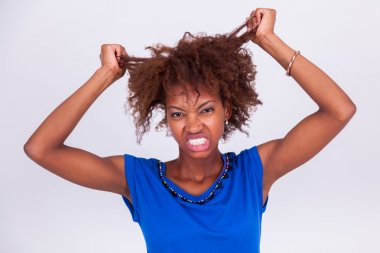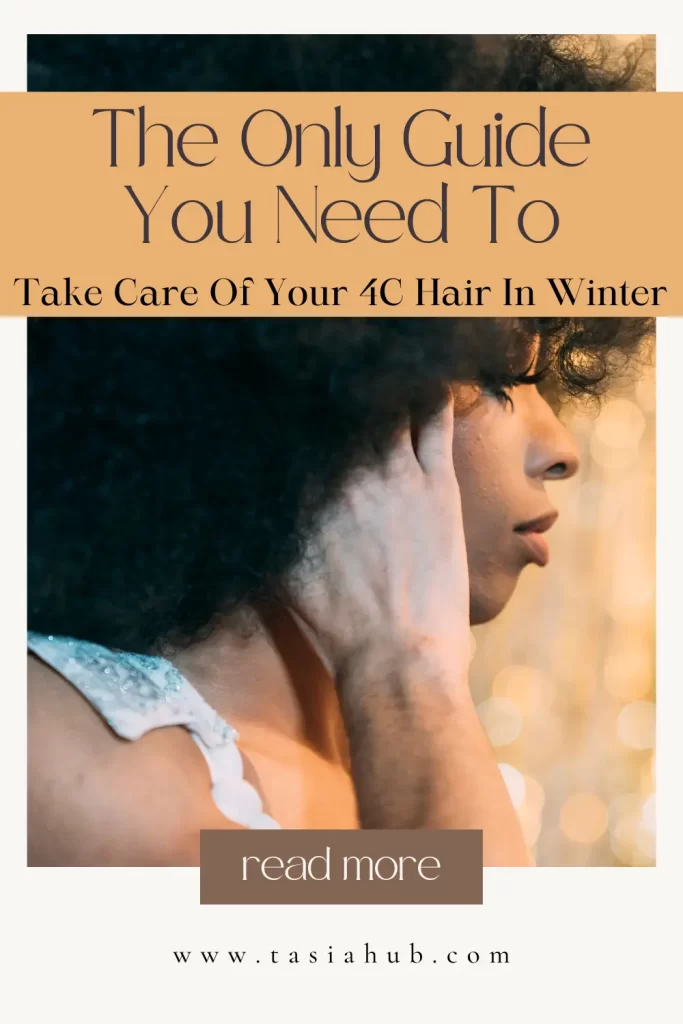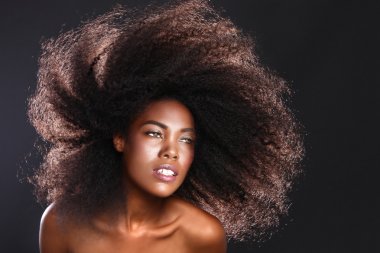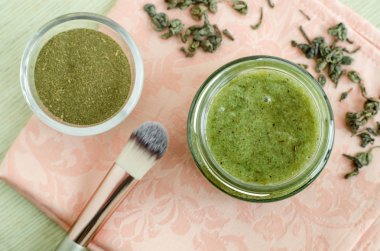A Comprehensive Guide On How To Take Care Of 4C Hair In Winter

How To Take Care Of 4C Hair In Winter
As the chilly embrace of winter settles in, it’s time to show some extra love to your gorgeous 4C hair. Discover the essential steps to keep your hair thriving and radiant despite the winter blues.
From protective styling secrets to nutrient-rich routines, we’ve got you covered with a comprehensive guide on how to take care of 4C hair in winter for a unique and stunning 4C hair. Let’s ensure your curls stay vibrant and healthy all season long!
This post contains affiliate links and I may earn a small commission when you click on the link at no additional cost to you. As an Amazon Affiliate, I earn from qualifying purchases, thank you.
Understanding Winter’s Impact on 4C Hair Health
Winter can be particularly challenging for 4C hair due to the cold and dry conditions. 4C hair is naturally prone to dryness, and the winter weather exacerbates this by zapping moisture from the hair strands.
The low humidity levels and harsh winds can leave 4C hair feeling even drier, resulting in increased frizz, difficulty with moisture retention, and a higher likelihood of split ends.
Additionally, winter accessories like hats and scarves, while necessary for warmth, can contribute to friction and tangles, further complicating the care routine.
Overall, the combination of cold, dry air, and external factors poses unique challenges for maintaining the moisture and health of 4C hair during the winter months.
Save this image for later!

How To Take Care Of 4C Hair In Winter In 10 Steps
Step 1. Embrace Protective Styles
Winter can be harsh on our beautiful 4C hair, but fear not – the secret weapon against the chill is embracing protective styles. These styles offer a myriad of benefits that go beyond just looking fabulous. Here’s a closer look at why protective styles are your go-to solution for winter hair care:
1. Moisture Retention:
- One of the key advantages of protective styles is their ability to lock in moisture. Winter air is notoriously dry and can strip 4C hair of its natural oils, leading to increased dryness and breakage. Protective styles, such as braids, twists, or updos, create a barrier that shields the hair from the harsh environmental elements, helping to retain essential moisture and keeping your curls hydrated.
2. Reduced Manipulation and Breakage:
- Winter chill often comes with a downside: the brisk wind can lead to more tangles and breakage. Protective styles help minimize the need for daily styling and detangling, reducing the risk of mechanical damage. With your hair neatly tucked away, you can navigate the winter breeze with confidence, knowing your curls are shielded from potential harm.
3. Length Retention:
- Protective styles play a crucial role in promoting length retention. By safeguarding your ends and minimizing exposure to harsh weather conditions, these styles create an environment conducive to healthy growth. This is particularly important during the winter months when dryness and brittleness can lead to split ends.
4. Versatility and Low Maintenance:
- Protective styles offer versatility, allowing you to experiment with various looks without compromising your hair’s health. Whether it’s braids, twists, or protective updos, these styles require minimal daily maintenance. This is especially beneficial during winter when spending less time manipulating your hair can contribute to overall hair health.
5. Stylish and Fashionable:
- Beyond their practical benefits, protective styles are undeniably stylish. They offer a chance to express your personality through different braiding patterns, twists, or creative updos. So, while you’re safeguarding your hair against the winter elements, you’re also turning heads with a chic and fashionable look.
Protective styles act as a formidable ally in the battle against winter hair woes. From locking in moisture to reducing breakage and promoting length retention, these styles are a versatile and stylish solution to keep your 4C hair flourishing, even in the coldest months.
Step 2. Washing With Lukewarm Water for Gentle Washes
When winter winds start to bite, our self-care routines need a thoughtful adjustment, and that includes the temperature of our hair washes. Opting for lukewarm water during the colder months comes with a multitude of benefits that contribute to the overall health and vibrancy of your 4C hair. Here’s a closer look at the benefits of washing 4C hair with lukewarm water:
1. Gentle on the Scalp:
- Lukewarm water is inherently gentler on your scalp compared to hot water. The latter can strip the scalp of its natural oils, leading to dryness and potential irritation. Lukewarm water ensures a soothing and comfortable wash, promoting a healthy scalp environment.
2. Preserves Natural Oils:
- 4C hair is naturally prone to dryness, and the winter weather can exacerbate this condition. Lukewarm water helps preserve the natural oils produced by the scalp, preventing excessive dryness. This is crucial for maintaining the moisture balance in your hair, ultimately preventing issues like brittleness and breakage.
3. Minimizes Moisture Loss:
- Hot water opens up the hair cuticles, making it easier for moisture to escape. Lukewarm water, on the other hand, is less harsh on the hair structure, minimizing moisture loss during the washing process. This is particularly beneficial in winter when dry air can already contribute to dehydrated hair.
4. Prevents Scalp Tightening:
- Hot water can cause the scalp to tighten, leading to discomfort and potential stress on the hair follicles. Lukewarm water provides a comfortable washing experience without causing unnecessary strain on your scalp. This is crucial for individuals with 4C hair, as maintaining a healthy scalp is paramount for overall hair health.
5. Enhances Product Absorption:
- Lukewarm water helps open the hair cuticle enough to allow for effective product penetration during the washing and conditioning process. This means that your hair strands can better absorb the nourishing ingredients from your chosen products, ensuring they work optimally to hydrate and strengthen your 4C curls.
Incorporating lukewarm water into your winter hair care routine is a small but impactful adjustment that can make a significant difference. By choosing the gentle warmth of lukewarm water, you’re not only preserving the health of your scalp and hair but also creating a foundation for vibrant and well-moisturized 4C curls throughout the winter season.
Step 3. Active Maintenance: Don’t Neglect Your Protective Styles
So, you’ve styled your 4C hair to absolute perfection, and you’re ready to conquer the winter with your fabulous look. But, hold on – the journey doesn’t end there.
Regular care for styled hair is the hero in maintaining that glamorous appearance, especially when facing the challenges that winter brings. Here’s why consistent care is the key to sustaining your styled 4C hair during the colder months:
1. Preserving Style Integrity:
- Your chosen hairstyle is a work of art, and regular care ensures its longevity. Whether it’s intricate braids, twists, or a chic updo, maintaining the integrity of the style requires ongoing attention. Regular care involves gentle detangling, securing loose ends, and addressing any signs of frizz or unraveling, allowing you to showcase your styled hair at its best.
2. Preventing Breakage and Damage:
- Winter conditions, with their dry air and harsh winds, can be unforgiving to styled hair. Regular care acts as a shield against potential breakage and damage. By consistently moisturizing, nourishing, and protecting your styled locks, you create a barrier that minimizes the impact of external elements, ensuring your hair stays resilient and beautiful.
3. Hydration Maintenance:
- Styled 4C hair often requires specific products and techniques to maintain optimal hydration. Regular care involves the consistent application of moisturizers, leave-ins, or oils to keep your hair well-hydrated. This is particularly crucial during winter when dry air threatens to rob your styled hair of its essential moisture.
4. Addressing Weather-Related Challenges:
- Winter weather brings its own set of challenges – from frizz-inducing winds to moisture-zapping cold. Regular care allows you to address these challenges head-on. Whether it’s reapplying protective products, adjusting your styling routine, or incorporating additional moisture-boosting treatments, consistent care ensures your styled hair remains resilient in the face of unpredictable weather.
5. Enhancing Style Longevity:
- Who says your styled hair can’t stand the test of time? With regular care, you can extend the life of your chosen style, minimizing the need for frequent restyling. This not only saves you time but also reduces the potential for unnecessary stress on your hair, contributing to its overall health and vibrancy.
The importance of regular care for styled 4C hair cannot be overstated, especially in the winter season. It’s the ongoing commitment to nurturing and protecting your styled locks that transforms a fleeting look into a lasting statement. So, as you flaunt your winter-ready hairstyle, remember that consistent care is the secret ingredient to maintaining that head-turning allure all season long.
Step 4. Vitamin E Oil: Your Winter Hair Protector
In the realm of winter hair care, few ingredients boast the protective prowess of Vitamin E oil, and for good reason. This golden elixir goes beyond its reputation as a skin-loving nutrient; it’s a powerhouse for nurturing and safeguarding your 4C hair, especially when the winter chill is in full swing. Let’s dive into the remarkable protective properties that make Vitamin E oil a must-have for your winter hair care arsenal:
1. Moisture Retention:
- Vitamin E oil is a champion at locking in moisture. In the winter, when dry air threatens to dehydrate your 4C curls, this oil acts as a barrier, preventing moisture loss and helping your hair maintain its essential hydration. Say goodbye to the brittleness that often accompanies winter weather – Vitamin E oil keeps your strands supple and nourished.
2. Shield Against Harsh Elements:
- The winter elements can be harsh on your hair, from biting winds to cold temperatures. Vitamin E oil forms a protective shield around each strand, serving as a natural defense mechanism. This shield minimizes the impact of external factors, helping to reduce frizz, breakage, and damage caused by the winter weather.
3. Scalp Nourishment:
- Healthy hair starts at the roots, and Vitamin E oil excels at nourishing the scalp. Applying this oil directly to the scalp promotes a well-hydrated and conditioned foundation for your 4C curls. A nourished scalp is more resilient against the dryness that often plagues winter, ensuring your hair grows from a healthy and robust base.
4. Anti-Oxidative Benefits:
- Vitamin E is renowned for its antioxidant properties. When applied to your 4C hair, it helps combat free radicals that can contribute to damage and premature aging. Think of it as a shield against environmental stressors, ensuring your curls not only survive but thrive in the face of winter’s challenges.
5. Repair and Restoration:
- If your 4C hair has been exposed to harsh winter conditions, Vitamin E oil steps in as a repair and restoration expert. Its nourishing properties aid in repairing damaged hair strands, sealing split ends, and revitalizing the overall health of your locks. This makes it an invaluable addition to your winter hair care routine, offering a helping hand in maintaining your hair’s vitality.





